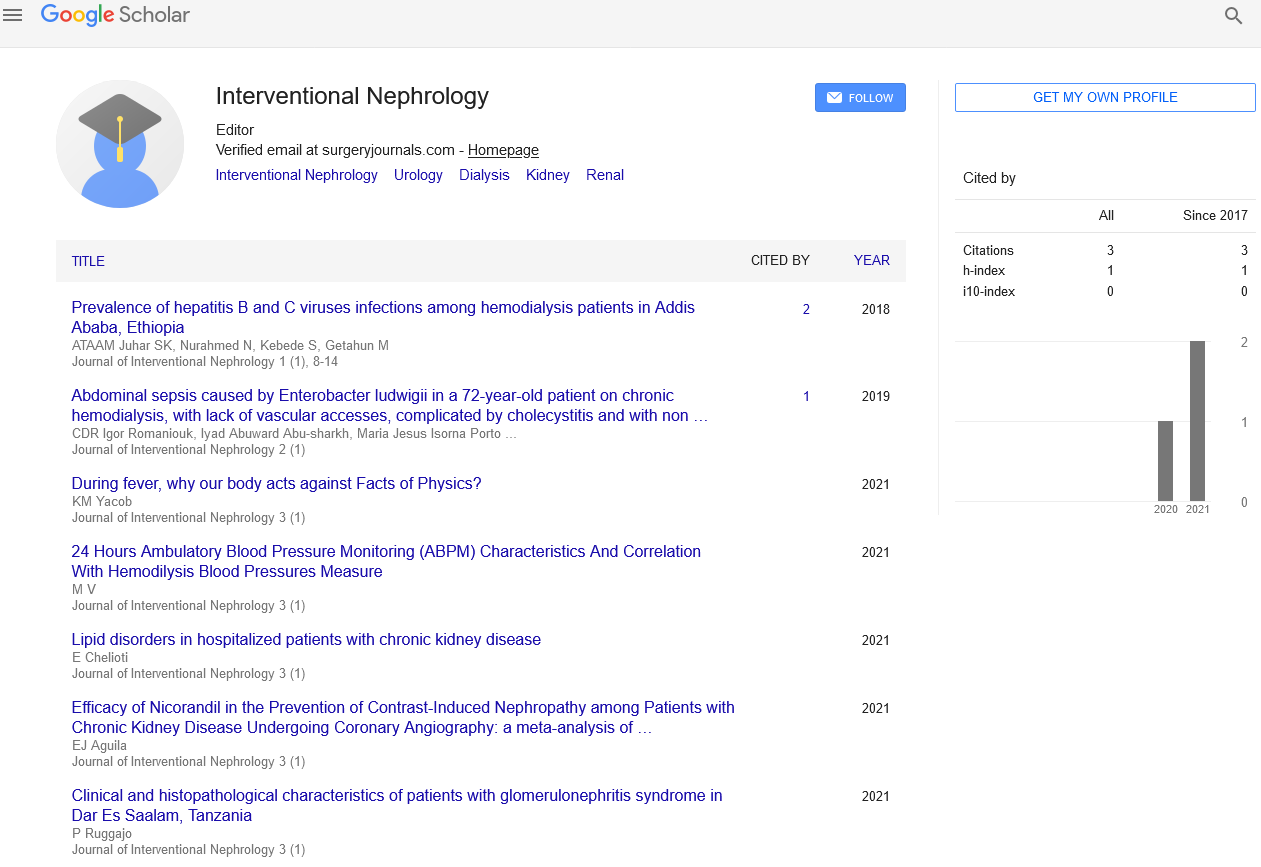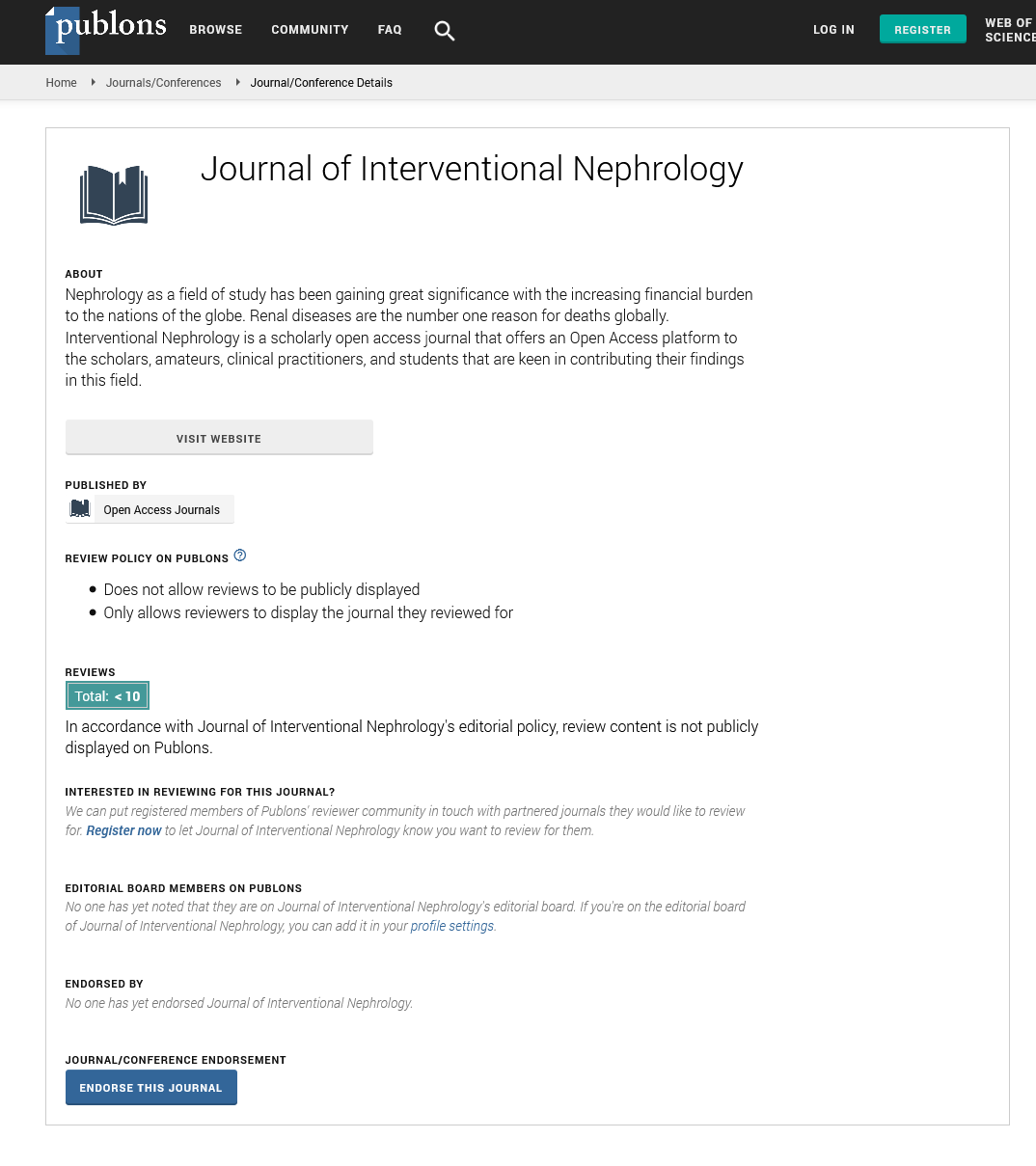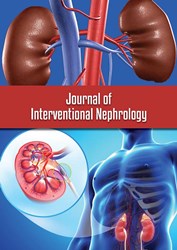Review Article - Journal of Interventional Nephrology (2022) Volume 5, Issue 5
Drug Elimination functions of renal
Bassanio Cameron*
St. Pauls Hospital, Vancouver, British Columbia, Canada
St. Pauls Hospital, Vancouver, British Columbia, Canada
E-mail: cameronbassanio@yahoo.com
Received: 01-Oct-2022, Manuscript No. OAIN-22-77373; Editor assigned: 03-Oct-2022, PreQC No. OAIN-22- 77373 (PQ); Reviewed: 17-Oct-2022, QC No. OAIN-22-77373; Revised: 22- Oct-2022, Manuscript No. OAIN-22- 77373 (R); Published: 29-Oct-2022; DOI: 10.47532/oain.2022.5(5).62-65
Abstract
Greater knowledge of the functions of renal drug transporters and drug-metabolizing enzymes in drug and chemical elimination as well as in modulating intrarenal exposure and response to drugs, nephrotoxic compounds, and physiological mediators has resulted from recent advances in the identification and characterization of these proteins. Additionally, regulatory authorities are also offering suggestions for the assessment of drug-drug interactions (DDIs) mediated by transporters that may be important due to the inhibition of renal transporters. A increasing corpus of research shows that individuals with chronic kidney disease have lower nonrenal clearances of medications removed through certain transporters and drug-metabolizing enzymes in addition to the well-known effects of kidney illness on renal drug clearance (CKD). Based on these findings, regulatory agencies’ renal impairment advice guidelines advise pharmacokinetic characterisation of medications that are cleared by the kidneys and those that are not in order to inform potential dose adjustments in CKD patients.
Introduction
The procedures used to eliminate a medication from the body are collectively referred to as drug elimination. It is commonly thought to include both metabolism and excretion in the pharmacokinetic ADME scheme (absorption, distribution, metabolism, and excretion). Drugs that are hydrophobic must undergo metabolic alteration to become more polar in order to be excreted. On the other hand, hydrophilic medications don’t need to undergo any metabolic modifications before they may be excreted. Despite the fact that there are several locations for both metabolism and excretion, the liver serves as the primary organs for metabolism while the kidney serves as the primary organ for excretion. The medication or its metabolites may build up in hazardous proportions if either organ exhibits any major malfunction. Extrinsic drug characteristics like polarity, size, or pKa can have an influence on elimination. The genetic makeup of people, illnesses that affect other organs, and routes involved in medication distribution across the body, such as first-pass metabolism, are additional considerations [1].
The body gradually gets rid of all medications. Either they are completely destroyed or they are chemically changed (metabolised). Most medications are mostly removed by the kidneys through urine, especially watersoluble medications and their metabolites. Therefore, renal function has a significant impact on medication dose. Some medications are excreted from the body in the bile (a greenish yellow fluid secreted by the liver and stored in the gallbladder).
Concerning Situations
Elimination of drugs refers to their removal from the body after administration. It can be done in one of two ways: either by excreting a medication that has not been metabolised in any manner or by metabolic biotransformation and then excretion. While the kidneys are largely responsible for excretion, other organ systems are also involved. Similar to this, although the liver serves as the principal site of biotransformation, extrahepatic metabolism occurs in a number of organ systems and affects a number of different medicines [2].
Drug elimination may be rather complicated because of the numerous organ systems and different metabolic transformations that are present. While hydrophobic medications require biotransformation before being eliminated, hydrophilic medications are often excreted directly by the kidneys. Both detoxifying the foreign chemicals and making them more hydrophilic through biotransformation, which ensures renal clearance, are the dual goals of this process [3].
There are two main metabolic routes through which drugs are transformed in the liver. Phase I involves directly altering the target molecule, whereas phase II involves conjugating the target to a polar, low-molecular-weight molecule. While single-phase metabolism does exist, phase I prepares the medication for phase II.
The foreign molecule is subjected to oxidation, reduction, and hydrolysis in phase I. Hepatic microsomal enzymes, which are found in the smooth endoplasmic reticulum of the hepatocytes, carry out these processes. The cytochrome P450 system, whose enzymes are mostly engaged in oxidative metabolism, is the most well-known among them. The CYP3A4 enzyme is a member of the cytochrome P450 family (CYP), and it is responsible for the metabolism of more than 50% of currently available medications. Its scope of activity includes opioids, immune suppressants, antihistamines, and benzodiazepines, among other groups of drugs. Pharmaceuticals are only one of the many things that interact with the enzymes and can either activate or inhibit them. Drugs that target that specific isoform perform less well because of the increased metabolic activity brought on by CYP activation. In contrast, CYP inhibition will raise medication plasma levels, which might cause toxicity. Phenytoin, phenobarbital, and St. John’s wort stimulate the CYP3A4, while diltiazem, erythromycin, and grapefruit inhibit it. Therefore, care must be taken when giving CYP3A4-metabolized medications while any of the inhibitors or inducers is present [4].
In phase II, polar groups are covalently joined to nonpolar molecules in order to make them water-soluble and enable renal or biliary evacuation. Target molecules can reach phase II immediately or after going through phase I’s initial processing. Transferred polar adjuncts include glutathione, amino acids, glucuronic acid, acetate, and sulphate. One of the main routes for phase II biotransformation is glutaronidation. This function is carried out by the UDP-glucuronosyltransferase (UGT) enzyme family. The activity of glucuronide derivatives is often reduced or absent compared to that of the parent chemical, although sometimes, pharmacologically active compounds are produced. A phase II metabolite of morphine with strong analgesic efficacy is morphine-6-glucuronide. Similar to the CYP enzymes, inducers, and inhibitors of phase II, conjugation-dependent medications are subject to the effects of enzymes, which may affect their efficacy [5].
Hepatic metabolism is characterised by the first-pass effect, which also contributes to the removal of many medicines. Here, the medications taken orally are exposed to the liver through the portal vein and undergo biotransformation there before being absorbed systemically. The dose given to the patient must account for the activity’s reduction in bioavailability. Drugs given intravenously are not affected by the first-pass effect [6].
Drug metabolism that occurs extrahepatically occurs in the GI tract, kidneys, lungs, plasma, and skin. The elimination process, which starts in the liver, is finished by renal excretion. Polar medications or their metabolites are often not reabsorbable because they are filtered in the kidneys. They are then eliminated through the urine. Due to the fact that medication ionisation varies depending on whether the environment is alkaline or acidic, urinary pH has a substantial influence on excretion. Weakly basic medications in acidic urine and weakly acidic drugs in basic urine both cause increased excretion [7].
One further important way for drugs to be eliminated is by excretion in the bile. Ionized medications having a molecular weight larger than 300 g/mol can be actively secreted by the liver into bile, where they enter the digestive system and are either excreted in faeces or reabsorbed as part of the enterohepatic cycle. Lungs, breast milk, perspiration, saliva, tears, and other bodily fluids are additional excretion routes [8].
Drug elimination in the urine
The kidneys’ capacity to eliminate medications is impacted by a number of elements, including specific drug properties. A medication or metabolite must be water soluble and not too firmly linked to proteins in the circulation in order to be widely eliminated in urine. The pace at which the kidneys eliminate various pharmaceuticals can be impacted by the acidity of urine, which is influenced by food, medications, and kidney problems. When treating drug poisoning, the urine’s acidity is altered by providing antacids (like sodium bicarbonate) or acidic compounds (like ammonium chloride) to hasten the drug’s elimination.
The capacity of the kidneys to eliminate medicines also depends on:
• Urine flow
• Blood flow through the kidneys
• The condition of the kidneys
Many diseases, including high blood pressure, diabetes, and recurrent kidney infections, as well as high levels of harmful chemicals and aging-related changes, can compromise kidney function. Kidney function gradually diminishes with ageing. For instance, an 85-yearkidney Old’s only discharge medications approximately half as effectively as those of a 35-year-old.
The “normal” dosage of a medication that is mostly removed through the kidneys may be excessive in patients whose renal function has decreased and may result in adverse effects. Because of this, doctors may have to change a patient’s medication dosage based on how much their kidney function has declined. Lower medication dosages are necessary for persons with impaired renal function compared to those with normal kidney function.
There are numerous ways for medical professionals to gauge the reduction in kidney function. They occasionally make an estimation based only on the person’s age. However, the findings of tests that gauge the amount of creatinine (a waste product) in the blood and occasionally the urine can provide a more precise estimation of kidney function. With the use of these findings, they determine the body’s ability to eliminate creatinine, or creatinine clearance (see Kidney Function Tests), which is a measure of how well the kidneys are working [9].
Drug elimination in the bile
Some medications are eliminated in the bile after passing through the liver unaltered. Before being eliminated in the bile, several medications are first transformed into metabolites in the liver. The bile subsequently moves into the digestive tract in both cases. From there, medications are either removed in faeces or recycled by being reabsorbed into the bloodstream.
The dosage of a medication that is mostly removed by metabolism in the liver may need to be changed if the liver is not working correctly. However, unlike kidney function, it is difficult to predict how efficiently the liver will process (and subsequently remove) medications [10].
Clinical Relevance
Drugs that are removed by the liver are impacted by hepatic disorders such liver cirrhosis. Increased half-lives of long-acting medicines due to compromised phase I and II metabolic pathways might enhance toxicity. A decrease in plasma protein in the presence of liver illness may result in an increase in the plasma percentage of unbound drugs. A drug’s dosage must be lowered to provide the same benefit as liver disease worsens. The metabolism of medicines can also be impacted by variations in hepatic perfusion. A drop in metabolic rate can occur under conditions that provide less blood flow to the liver, such as shock, hypovolemia, or hypotension.
Drug excretion may be hampered by renal illnesses such chronic kidney disease, which affect renal function. Drug excretion is less effective as kidney function ages, necessitating possible dosage modifications. Pathologies that influence renal blood flow or urine flow can also impair medication clearance in addition to direct renal dysfunction. Congestive heart failure, liver disease, and diseases that alter the secretion of antidiuretic hormone are a few examples of these conditions.
Interprofessional Team Monitoring, Nursing, and Allied Health Interventions
Both liver and kidney function deteriorate in older persons. The Beers Criteria were created to provide risk stratification in the elderly population and are helpful for prescribing drugs to those over 65. Similar dose modifications must be made when giving medications to people who have renal or liver illness or who have diseases that may damage those organs. Every drug’s package insert from the manufacturer addresses unique renal and hepatic dosage issues that the medical staff should be aware of for their patients.
Nurses must keep medication elimination in mind while caring for patients who have hepatic or renal illness or diseases that affect those organs. Drug dosages (and/or dosing frequency) may need to be reduced, and certain medications may need to be stopped altogether. If the use of a certain medication is absolutely required, meticulous monitoring for side effects is crucial. The plasma concentration of medications like vancomycin or phenytoin still has to be monitored in individuals without liver or renal pathology to make sure it stays within the therapeutic range.
References
- Corsini A, Bortolini M. Drug-induced liver injury: the role of drug metabolism and transport. J Clin Pharmacol. 53, 463-474 (2013).
- Zeng M, Yang L, He D et al. Metabolic pathways and pharmacokinetics of natural medicines with low permeability. Drug Metab Rev. 49, 464-476 (2017).
- Johnson HL, Maibach HI. Drug excretion in human eccrine sweat. J Invest Dermatol. 56, 182-188 (1971).
- Stowe CM, Plaa GL. Extrarenal excretion of drugs and chemicals. Annu Rev Pharmacol. 8, 337-356 (1968).
- Almazroo OA, Miah MK, Venkataramanan R. Drug Metabolism in the Liver. Clin Liver Dis. 21, 1-20 (2017).
- By the American Geriatrics Society 2015 Beers Criteria Update Expert Panel. American Geriatrics Society 2015 Updated Beers Criteria for Potentially Inappropriate Medication Use in Older Adults. J Am Geriatr Soc. 63, 2227-2246 (2015).
- Asconape JJ. Use of antiepileptic drugs in hepatic and renal disease. Handb Clin Neurol. 119, 417-432 (2014).
- Idkaidek NM. Comparative assessment of saliva and plasma for drug bioavailability and bioequivalence studies in humans. Saudi Pharm J. 25, 671-675 (2017).
- Webster AC, Nagler EV, Morton RL, et al. Chronic kidney disease. The lancet. 389, 1238-1252 (2017).
- Nyengaard JR. Stereologic methods and their application in kidney research. Journal of the American Society of Nephrology. 10, 1100-1123 (1999).
Indexed at, Google Scholar, Crossref
Indexed at, Google Scholar, Crossref
Indexed at, Google Scholar, Crossref
Indexed at, Google Scholar, Crossref
Indexed at, Google Scholar, Crossref
Indexed at, Google Scholar, Crossref
Indexed at, Google Scholar, Crossref


